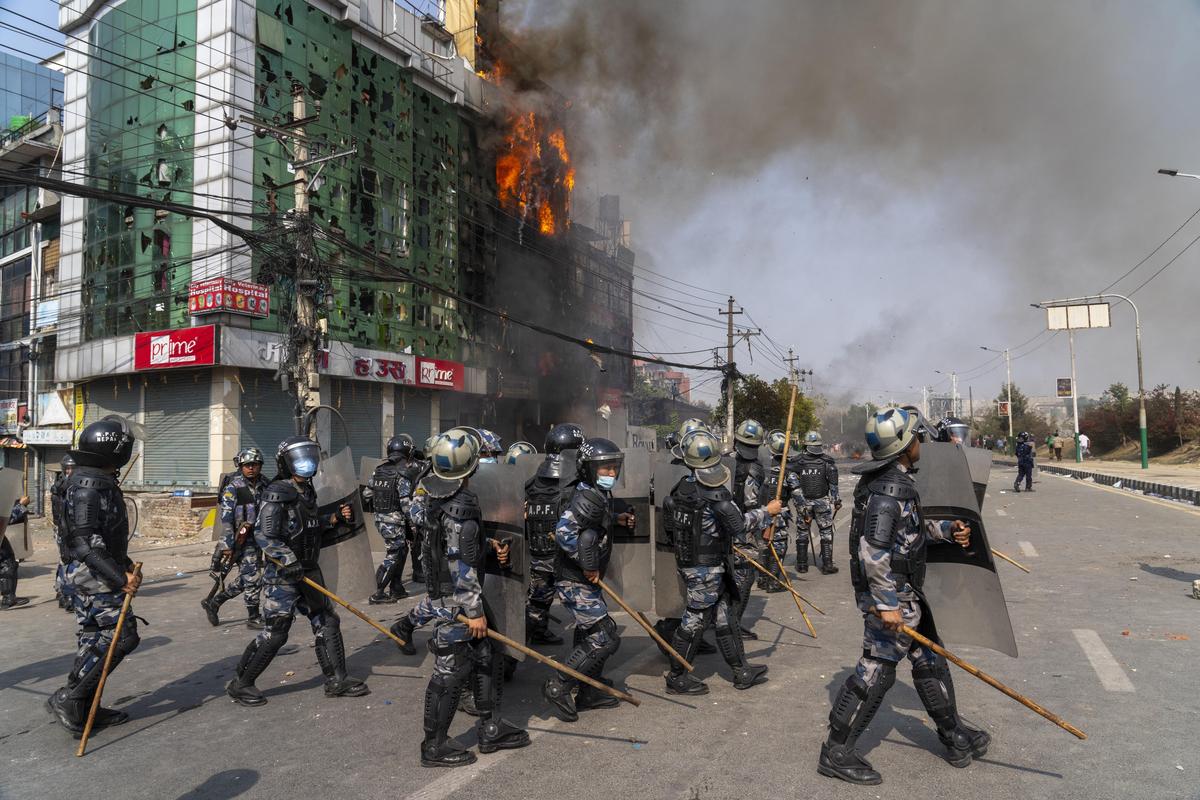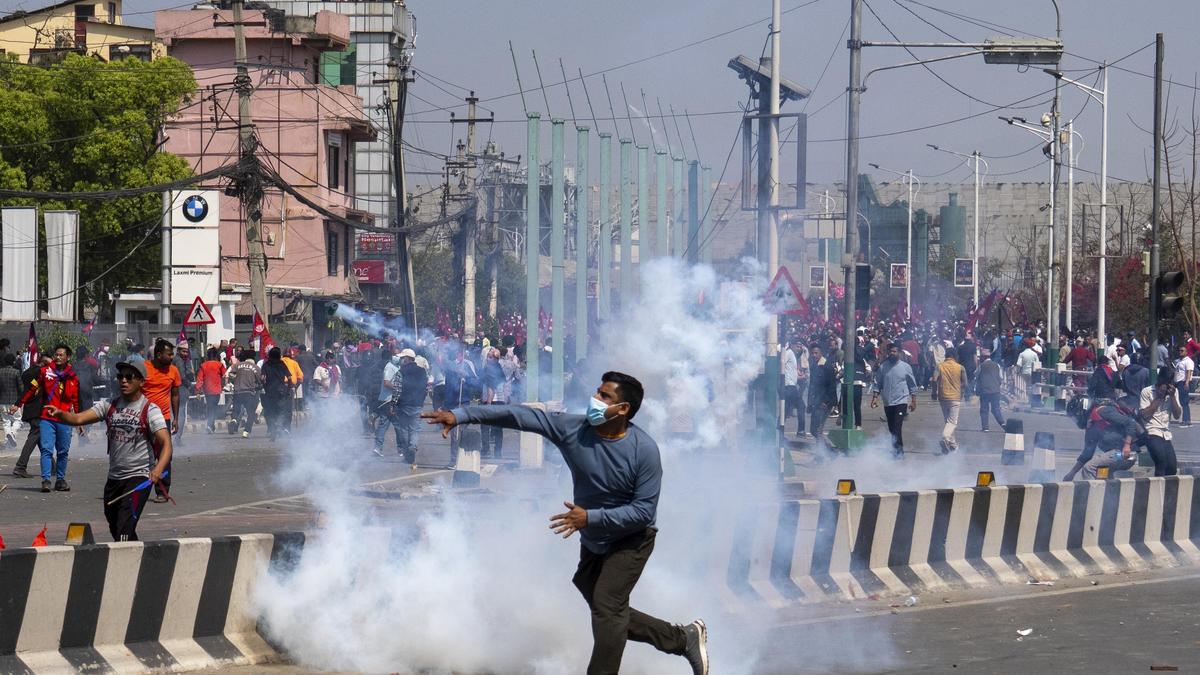In 2005, then-King Gyanendra Shah, after assuming absolute power in a royal-military coup, mobilised Nepal Army vehicles on the streets of Kathmandu to enforce his rule with an iron fist.
Two decades later, on Friday (March 28, 2025) evening, Army vehicles rolled through parts of Kathmandu again—but this time, the government deployed them to restore order after a protest by supporters of the same Gyanendra turned violent.
The government imposed a curfew after clashes between protesters demanding the restoration of the monarchy and security forces left two people dead and scores of others injured. The curfew was lifted on Saturday morning at seven.
Friday’s protest was organised jointly by the royalist party Rastriya Prajatantra Party (RPP), which is the fifth-largest force in the Nepali Parliament, and another loose group of people advocating for the monarchy’s restoration, which was abolished in 2008.
The gathering near the international airport in eastern Kathmandu was initially announced as a peaceful rally. However, it turned violent when protesters broke through a police barricade and pelted stones at security personnel. In response, the police fired tear gas shells, rubber bullets, and used water cannons. Protesters also vandalised private buildings, set a house on fire, and attacked media houses.
According to the police, a video journalist died in a fire after being trapped in a building set alight by protesters. Another person, a protester, was killed in clashes.
Nepal has seen a fresh wave of pro-monarchist movements in recent months, with supporters accusing the country’s political parties of corruption, ineptitude, and failure to deliver on their promises.
A desperate bid
Mr. Shah, 77, was an accidental King. He ascended to the throne after his brother, King Birendra, and most of their family were killed in a royal massacre in 2001. Initially a ceremonial head of state with no executive powers, in 2005, he dissolved the government, imprisoned politicians, declared a state of emergency, attacked the media, and deployed the army to run the country.
The 2006 mass movements forced Mr. Shah to hand over power to a democratically elected government. Two years later, an elected Constituent Assembly voted to abolish the monarchy altogether.
Narayana Wagle, who edited Kantipur, a major vernacular daily during the 2006 movement, believes the pro-monarchist rallies are part of Mr. Shah’s desperate attempt to “create a space” for himself.
“Now that he knows there is no legitimate way for him to return as a ruler, he is attempting such methods, like orchestrating rallies with some figures discredited in society,” said Mr. Wagle.

Police secure the site of a house set on fire by a pro-monarchist group during a protest in Kathmandu, Nepal, on Friday, March 28, 2025.
| Photo Credit:
AP
As public frustration grows with Nepal’s political parties, Mr. Shah is trying to capitalise on the discontent. In the past two decades, corruption, impunity, poor service delivery, lack of jobs, a weak economy, and an unfavourable business environment have fuelled public anger toward Nepal’s main political parties, including current Prime Minister K.P. Oli’s.
Monarchists run amok
Earlier this month, on March 9, Mr. Shah received a rousing welcome from royalist forces upon his arrival in Kathmandu from Pokhara, a tourist town about 200 kilometres to the west. Estimated at between 10,000 and 15,000, the crowd was modest enough to embolden pro-monarchists.
Ahead of Friday’s rally, the pro-monarchists appointed Durga Prasai, a controversial figure, as the rally’s “commander.” Mr. Prasai, a “medical businessman” who rose to prominence under the wings of Mr. Oli and former Prime Minister Pushpa Kamal Dahal, had previously campaigned against paying bank loans. More recently, he has emerged as the self-styled savior of the monarchy.
With another gathering organised by republican forces in another part of Kathmandu, the administration designated an area near the airport for the royalist forces. But Mr. Prasai breached the barricade and drove his vehicle toward security personnel, calling for protesters to follow him. Chaos engulfed the streets soon after.
A former police officer who has closely followed recent events said the protest spiralled out of control because protesters became unruly, and the administration and security forces failed to properly assess the situation.
“The two deaths and the property damage could possibly have been prevented if the situation had been better assessed,” said Hemant Malla, a former deputy inspector general of the Nepali Police. “There seems to be some security lapse as well, as preparations should have accounted for the recent March 9 rally.”
Mr. Malla also noted that security forces were stretched thin, as another large gathering of around 35,000 people was taking place elsewhere in Kathmandu.
Prime Minister Oli called an emergency Cabinet meeting late on Friday night to review the situation. Home Minister Ramesh Lekhak announced on Saturday that those involved in looting, arson, and inciting the crowd would be prosecuted.
On Friday, police arrested several RPP leaders, including Member of Parliament Dhawal Shumsher Rana and party senior vice president Rabindra Mishra. Meanwhile, Mr. Prasai remains at large, with authorities continuing their search for him.
Republicans react
At the republicans’ rally, organised by a Left front, of which Mr. Oli’s Communist Party of Nepal (Unified Marxist-Leninist) is not part, that was being held in Kathmandu just as pro-monarchists were protesting, Mr. Dahal, chairman of the CPN (Maoist Centre), warned Mr. Shah that his bid to reclaim the throne could prove costly to him.
The Nepali Congress, a key coalition partner in the Oli government, said in a statement that “it calls on all to move on the peaceful path prescribed by the constitution.”
Ever since the pro-monarchy rallies have surged, Nepali political parties have been issuing warnings to Mr. Shah and asking him to stop dreaming about reclaiming the throne and instead contest the elections.
Analysts say the defenders of the republic should focus on delivery and strengthening the republican system.
“Provocative statements by politicians could be counterproductive at a time when there is growing discontent among the public with the parties,” said Mr. Malla. “Whether the Army vehicles should have been brought on the streets also begs a question, as a curfew had already been declared and the police could have taken care of.”
A few days ago, in response to some reports and social media posts imploring the Army to support the reinstatement of the monarchy, it had said in a statement that it is committed to fulfilling its constitutional responsibilities.
Mr. Wagle said the Army may have been called to aid police in enforcing the curfew and that there was no need to read too much into it.
“The point is, even amid growing discontent, Mr. Shah stands little chance,” he said. “What Nepali parties need to do is reform. The media and civil society need to be more vigilant in holding them accountable and pushing politicians to make democracy functional.”
Published – March 29, 2025 06:24 pm IST

